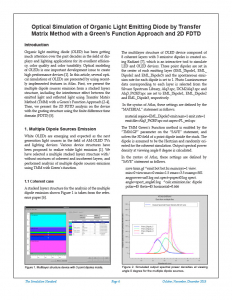Optical Simulation of Organic Light Emitting Diode by Transfer Matrix Method with a Green’s Function Approach and 2D FDTD
Introduction
Organic light emitting diode (OLED) has been getting much attention over the past decades in the field of displays and lighting applications for its excellent efficiency, color quality and color tunability. Optical modeling of OLEDs is one important development issue to create high performance devices [1]. In this article, several optical simulations of OLEDs are presented by using recently implemented features in Atlas. First, we present the multiple dipole sources emission from a stacked layers structure, including the interference effect between the emitted light and reflected light using Transfer Matrix Method (TMM) with a Green’s Function Approach [2-4]. Then, we present the 2D FDTD analysis on the device with the grating structure using the finite difference time domain (FDTD) [5].
1. Multiple Dipole Sources Emission
White OLEDs are emerging and expected as the next generation light sources in the field of AM-OLED TVs and lighting devices. Various device structures have been proposed to realize white light emission [1]. We have selected a multiple stacked layers structure with/without mixtures of coherent and incoherent layers, and performed analysis of multiple dipole sources emission using TMM with Green’s function.



